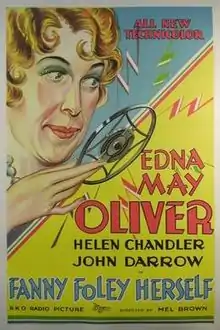Fanny Foley Herself
Fanny Foley Herself is a 1931 American Pre-Code comedy-drama film shot entirely in Technicolor. The film was the second feature to be filmed using a new Technicolor process which removed grain and resulted in improved color. It was released under the title Top of the Bill in Britain.
| Fanny Foley Herself | |
|---|---|
 Theatrical poster for film | |
| Directed by | Melville W. Brown |
| Produced by | John E. Burch (supervisor)[1][2] |
| Written by | Juliet Wilbur Tompkins (story) Carey Wilson (adaptation & dialogue) Bernard Schubert (add'l dialogue) |
| Starring | Edna May Oliver Helen Chandler John Darrow |
| Music by | Max Steiner |
| Cinematography | Ray Rennahan |
Production company | |
| Distributed by | RKO Radio Pictures |
Release date |
|
Running time | 73 minutes |
| Country | United States |
| Language | English |
Plot
Edna May Oliver plays a widowed woman with two daughters (Helen Chandler, Rochelle Hudson) who attempts to revive her career as a vaudeville performer. Her wealthy father-in-law, who believes that a vaudeville performer is not fit to bring up children properly, forces her to choose between her daughters or her career. In the end, all is forgiven and the father-in-law asks Fanny to sing one of her songs.
Cast
- Edna May Oliver as Fanny Foley
- Hobart Bosworth as Seely
- Florence Roberts as Lucy
- Rochelle Hudson as Carmen
- Helen Chandler as Lenore
- John Darrow as Teddy
- Robert Emmett O'Connor as Burns
- Harry Stubbs as Crosby
Production background
- As a result of the quality of the color work in The Runaround (1931), Radio Pictures decided to produce three more pictures in the improved Technicolor process.[3] Only Fanny Foley Herself was completed and released in Technicolor. The titles of the two other features were Marcheta and Bird of Paradise. Marcheta seems to have been abandoned, while Bird of Paradise was changed into a black-and-white production starring Dolores del Río and Joel McCrea
- This was Edna May Oliver's first appearance in color. She would appear in color only once more, in the 1939 film Drums Along the Mohawk. She did not appear in the Technicolor sequences of The American Venus (1926).
- This was Helen Chandler's only appearance in a color film. She did not appear in the color sequences of Radio Parade of 1935 (1934). She may have appeared in the color sequences of the silent film The Joy Girl (1927). This film, rumored to exist at the Museum of Modern Art, is unavailable for inspection.
Reception
In October 1931 The New York Times said "There are greenish skies, steel-tinted nights, amber lights, frocks and gowns of pastel shades, most of this prismatic work being quite well done. But whether it is, on the whole, more effective than black and white is a matter of opinion."[1]
Preservation status
The film is now considered to be a lost film. But a Trailer Survives 200 ft.
References
- "Fanny Foley Herself". American Film Institute. Archived from the original on April 3, 2014. Retrieved January 31, 2015.
- Jewell, Richard B.; Harbin, Vernon (1982). The RKO Story. New York: Arlington House. p. 41. ISBN 0-517-546566.
- Los Angeles Times; September 13, 1931; Page B13.